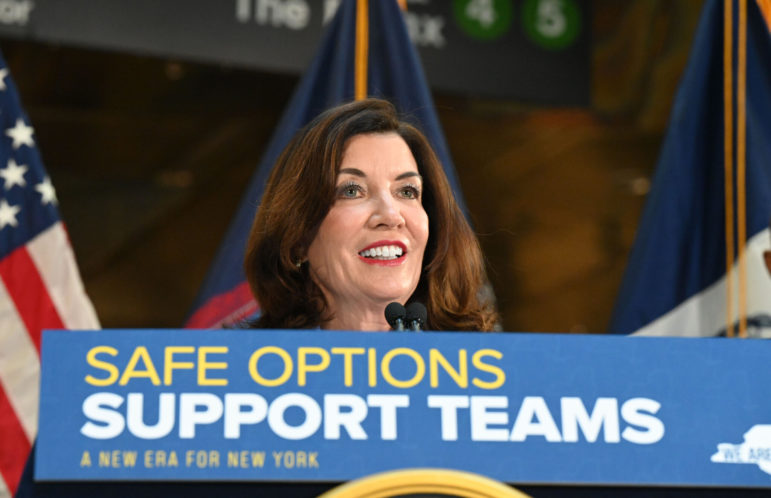Kathy Hochul’s first State of the State proposal included sweeping plans for affordable housing, free legal assistance for low-income tenants and sending social workers into the subways to conduct homeless outreach. But the governor failed to address other high-profile issues, like the end of pandemic eviction protections and the “Good Cause” eviction bill.

Kevin P. Coughlin / Office of Governor Kathy Hochul
Gov. Hochul last week unveiled her plan to use “Safe Option Support” (SOS) outreach teams, made up of mental health professionals who canvas the subways and refer homeless New Yorkers to city-run shelters and services.With more than 55,000 people in New York City’s various homeless shelter systems, hundreds of thousands of state residents behind on their rent and eviction protections ending in less than a week, it’s a grim and uncertain time for the Empire State.
Gov. Kathy Hochul pledged to tackle these issues during her first State of the State address last week, proposing measures to stave off a wave of evictions (but not extending the current freeze) while explicitly linking the homelessness crisis to the need for more affordable housing.
In a 237-page text accompanying the speech, Hochul provided more details about her policy proposals, which include the construction or preservation of 100,000 affordable housing units and plans to expand access to free attorneys for low-income tenants in housing court.
Her acknowledgement of the interrelated homelessness and housing crises earned praise from advocates, as did her stated commitment to keeping families out of shelters. But what she left out of her proposals—particularly a stance on the state’s Good Cause eviction legislation—has also faced scrutiny from renters, people experiencing homelessness and their advocates.
Here are five other key takeaways from Hochul’s proposals and omissions.
Preparing for the end of eviction protections
Hochul made clear in her policy text that she will not seek to extend the pandemic eviction protections that first began with an executive order from her predecessor in March 2020. Since then, relatively few New Yorkers have been ejected from their homes with a judge’s order, even if they owed significant back rent.
But the end of the protections could unleash a wave of new eviction filings, considering that roughly one-third of New York’s low-income renters have fallen behind on their rent during the pandemic.
Several lawmakers have backed the creation of a right-to-counsel law across the state modeled off a New York City law that provides all low-income renters with representation in eviction cases. Hochul stopped short of calling for such a law outright, but said she wants to create a Eviction Prevention Legal Assistance Program, which will provide “free legal assistance” to upstate renters who cannot afford a lawyer.
The program would apply to tenants facing eviction who earn at or below 200 percent of the federal poverty line—about $44,000 for a family of three. As in New York City, the state program would fund existing legal service providers, like the Legal Aid Society of Northeastern New York and Legal Services of Central New York.
A new development a day after Hochul’s speech could provide additional protection for tenants via New York’s Emergency Rental Assistance Program (ERAP).From June until November 2021, ERAP covered arrears for more than 100,000 households, with another provision prohibiting their landlords from seeking an eviction.
Another nearly 200,000 households did not receive funding after the program ran out of cash, but they did get a potential defense in housing court in the form of their ERAP applications, since state law allows renters to show a judge that they have applied for back rent as a defense against eviction. But an untold number of New Yorkers missed out on the application period when the state’s Office of Temporary and Disability Assistance (OTDA) closed the portal for the tapped-out fund in November.
Hochul asked the U.S. Treasury Department for about $1 billion to replenish the fund. Last month, the federal government responded with a check for about $28 million—0.3 percent of Hochul’s request, Law360 reported.
The ERAP saga didn’t end there. A state supreme court judge on Thursday ordered OTDA to reopen its application portal within three days, ruling that the closure was arbitrary and exposed tenants to eviction even though the federal government may come through with more funding in March.
Tenants “should have the benefit of being able to apply for ERAP now and obtain their rightful place on a de facto waitlist rather than wait and join the onslaught of applications [New York State] may receive if it reopens the ERAP portal upon obtaining sufficient funding after March,” wrote Justice Lynn Kotler.
An OTDA spokesperson said they are reviewing the ruling.
No stance on Good Cause
A fight over the Good Cause eviction bill will be among the highest-profile housing-related issues facing state lawmakers this session, but Hochul has so far declined to weigh in. She didn’t hint at her position in the speech or policy book, either.
The measure would give tenants the right to a lease renewal in most cases and curb unlimited rent hikes in non-stabilized apartments—thus blocking eviction without “good cause” and extending key rent stabilization protections to tenants in buildings with fewer than six units.
The legislation has strong support among progressive Democrats in both chambers, but legislative leaders have not yet embraced the measure. Still, Senate Majority Leader Andrea Stewart-Cousins has sponsored a similar bill. Advocates hope to sway Assembly Speaker Carl Heastie, who has resisted the measure, as evictions are likely to surge in the coming months.
A decision by influential tenant advocates and lawmakers to back off their demands for an eviction moratorium extension could make Hochul and Heastie more amenable to Good Cause.
Nevertheless, the bill is anathema to landlords, who have mounted an aggressive campaign against what they liken to universal rent control.
‘Direct action’ on street homelessness
A day after her speech, Hochul visited New York City to describe a specific element of her plan to address street homelessness: “Safe Option Support” (SOS) outreach teams. The state-funded teams will be made up of mental health professionals who canvas the subways and refer homeless New Yorkers to city-run shelters and services.
This proposal coincides with a plan by Mayor Eric Adams to flood the subways with NYPD officers amid a perception of crime and danger underground—a perception stoked by Hochul’s predecessor and her primary gubernatorial rival. The pledge to increase the police presence has concerned advocates who say it will lead to more aggressive and punitive encounters with New Yorkers staying on the trains.
Speaking Thursday, Adams said he will assign an “omnipresent” police presence in the subway station, but that cops will not engage with homeless New Yorkers. Instead, they will contact the SOS teams to conduct outreach.
But those SOS teams are still just a concept in the Requests for Proposals phase. So how will the surge in subway cops address homelessness in the interim?
A spokesperson for Adams referred questions about the program to Hochul’s office. The governor’s office directed questions to the Office of Mental Health (OMH). An OMH spokesperson said the SOS teams would be up and running in the spring.
Homeless rights advocates assailed the plan’s link to policing.
“The NYPD should not, under any circumstances, be first responders to people in need of clinical expertise,” added New York Civil Liberties Union Executive Director Donna Lieberman. “Mental health crises should be addressed with a trauma-informed response, not an approach that inflicts further trauma and endangers the lives of the very people the NYPD is supposed to serve.”
“We recommend that NYPD stay out of homeless outreach, and instead that the city and state empower homeless outreach teams to provide basic needs items and then permanent housing,” added Karim Walker, outreach specialist with the organization Human.nyc. “More outreach without more housing is not useful.”
Addressing the affordability crisis
Hochul discussed the urgent need for more affordable housing to address homelessness and proposed a five-year, $25 billion plan to create and preserve 100,000 units for low- and middle-income New Yorkers. That includes creating 7,000 new units of supportive housing while preserving 3,000 others.
The supportive housing pledge “goes above and beyond previous commitments and heeds advocates’ calls for much-needed predictability for developers and service providers alike,” said Supportive Housing Network of New York Executive Director Laura Mascuch.
Hochul is prioritizing at least one measure that would fuel faster home creation—or legalize some unlawful homes that already exist. She supports allowing accessory dwelling units (ADUs) like basement apartments, carriage houses and “in-law suites” in areas zoned for single family homes. The housing capital plan would direct money to municipalities and nonprofits to help homeowners get their ADUs up to code. The fund could revive a New York City pilot program intended to upgrade basement apartments, which are a vital, but often unregulated and potentially dangerous, form of housing for hundreds of thousands of New Yorkers.
Hochul also said she would back measures to change zoning-related laws to increase density, such as a state rule that caps residential density at a floor area ratio (FAR) of 12 in New York City (FAR refers to the maximum square footage of a building allowed by local zoning rules, based on multiples of the lot size. So an FAR of 12 means 12 times the size of the property lot).
And she wants to amend state law to allow for hotels within 800 feet of a residential district to be converted into permanent, affordable homes. That mirrors a provision struck from the final text of the state’s Housing Our Neighbors with Dignity Act (HONDA), which unlocks funds for the conversion of hotel rooms into affordable apartments for homeless New York City residents.
Partnership for the Homeless President and CEO Áine Duggan welcomed Hochul’s focus on housing as the solution to the homelessness crisis, but said her plans will fail if more people continue to lose their homes and fill shelters.
“The governor’s plan can only succeed if it prevents more people from losing their homes while simultaneously assisting those currently experiencing homelessness to become stably housed,” Duggan said. “To this end, extending the moratorium, securing new federal funding for rental assistance and working with community organizations, tenants and property owners to efficiently disseminate rental assistance funds is an important foundation upon which to build the state’s new housing plan.”
Embracing community-controlled housing
Hochul also backed opportunities for affordable homeownership in New York City through the creation of community land trusts (CLTs) and other forms of “community-controlled housing.” Under the CLT model, land is owned by nonprofit community-based organizations that rent or sell the housing to lower-income households. Homeowners on CLTs cannot sell their units at a steep profit, thus fending off speculators and keeping the housing permanently affordable.
There is a “growing desire in communities across New York to take more control over their housing environments,” Hochul’s policy book states. She is pushing for a pilot program that will fund the creation of various community-controlled housing models, including Mitchell-Lama-style limited equity coops and CLTs.
The proposal, along with Hochul’s plan to allow New Yorkers to take alcoholic drinks from bars and restaurants, earned the approval of Housing Justice For All organizer Cea Weaver.
“This and to-go drinks are the good parts,” Weaver tweeted.









